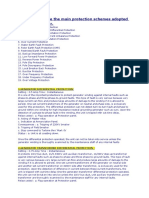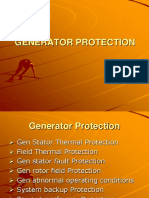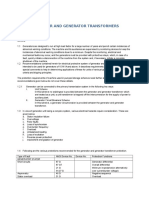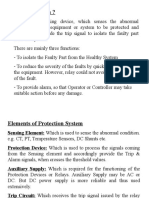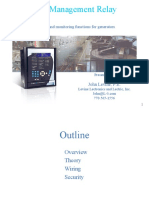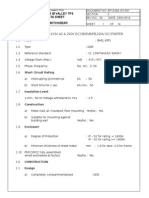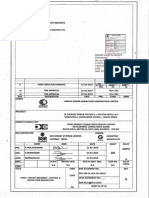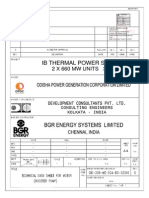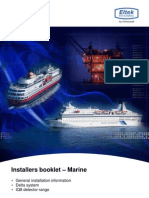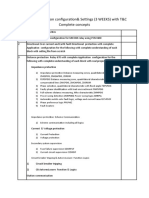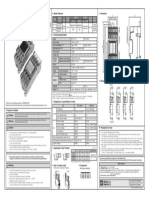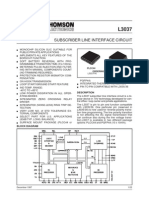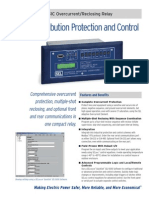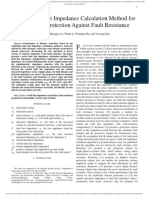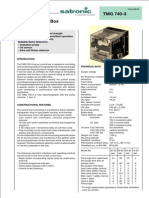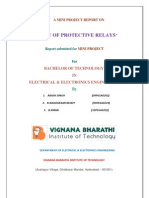GENERATOR PROTECTION
prashant ektate
�INTENTION OF GENERATOR PROTECTION
Power is need of time.
To keep generator operating in healthy condition
different types of protections are provided, to avoid
damages to plant as well as power system.
Protections give alarm in abnormal conditions &
trips the Gen with time delay or instantaneously
depending on nature of fault.
CTs & PTs are the heart of protection system
�Various fault involved
Faults involving in stator winding (protection of stator)
Phase to phase short circuit
phase to ground
short circuit between turns
and open circuit in stator winding.
Generator stator winding over heating.
Faults involving generator rotor
Short circuit in rotor winding.
open circuit in rotor winding
(develops very high voltage across terminals)
rotor earth fault i.e. field earth.
Over heating of rotor .
� Other electrical faults:Motoring
loss of field or weak field
out of step operation
under voltage
over voltage
under frequency
over frequency
single phasing
RPP
back up impedance
LBB etc
�CT& PT : ARE MEASURING TRANSFORMERS
CTs are divided in two groups:One group consists of protection class for protection circuit.
Other one is Metering class for measurement circuit.
CT current transformer:- Are mounted in
1. Generator Phase side &Neutral side of bus duct.
2. In Neutral grounding transformer cubicle
-for stator earth fault protection.
3.Differential protection CTs are independent
i/e No other protection other than differential on it.
4.In GT turret CTs are provided for protection of transformer.
5. One separate CT in yard for overall differential & REF
6. Generator CT ratio are 25,000/5 Amp( As applied to 660MW).
Secondary currents are used for measurement & protection.
�POTENTIAL TRANSFORMERs
PT primary voltages are tapped from generator bus duct.
PTs are located in PT cubicle.
PT ratio is 22Kv/3/110/3 V.( generating voltage is 22KV )
Secondary voltages of PTs are used for :Protection relays
Metering purpose
AVR
EHG
�LINE DIAGRAM INDICATING POSITIONS OF CT & PT:
�SOME BASIC INFORMATION REGARDING RELAYS
Each protection relay have specific number.
The mentioned numbers are as per KKS code , which are universally
accepted one.
Secondly the name itself indicate operating quantity, basic movement,
application .
e.g..-C- current operated, V- voltage operated, W- power relay, Ffrequency, D-differential, Y-impedance, G-Over flux ,N-Earth fault etc.
In U #5 numerical relays are used.
�In conventional type protection, each protections have separate
relay with separate timer. Tripping logics are developed externally.
In U #1 to 5 microprocessors based numerical relays are used. It
can be used for any CT/PT ratio without additional interposing
transformers to match correction.
Whenever any protection relay operates, initiates trip command to
Master trip relay -86.Master trip initiates GCB trip command.
�Advantages of numerical relays
Reliability
Multi functionality
Self-diagnosis
Event and disturbance records
Communication capabilities
Adaptive protection
�VARIOUS GENERATOR PROTECTIONS:Generator differential protection 87-G
Generator Thermal overload protection 51GTH
Generator over current protection 50GS
Stator earth fault 95% 64G1
Stator earth fault 100% 64G2
Stator back up earth fault 64G3
Rotor earth fault protection 64R
Negative phase sequence 48G
Over fluxing 99G
�Generator over voltage protection 59G
Generator under voltage protection 27G
Generator low forward power 37G
Reverse power protection 32 AG
Generator over & under frequency protection 81G
Voltage balance protection 160, 260, 360
Generator under voltage protection
Generator inter-turn fault protection 95G
LBB local breaker back up 50LBB
loss of excitation 40G
Pole slip 78G
�TRIP LOGIC OF GENERATOR PROTECTION
CLASS A TRIP:
all electrical trip
Over/under voltage
Over/ under frequency
Field failure
over current
Differential
Stator/ Rotor E.F
LBB
Pole slip, etc.
CLASS-B TRIP:
Mechanical trips
Avoid over speeding of turbine due to steam entrapped in turbine.
Turbine trip signal is initiaed first
Then the active power, sensed by the low forward relay (32L)
gives the trip signal to the unit breaker & field breaker after a time delay.
HV CB, field breaker are tripped.
�CLASS-C TRIP:
Trips only HV CB, Generator remains in
service feeding auxiliary load.
�VARIOUS TYPES OF FAULT, EFFECTS THERE OF &
PROTECTION TO BE OPERATED.
FAULT/ABNML CONDN
Thermal over loading
External fault
EFFECT
PROTECTION
Over heating of stator
Thermo couples/
wdg/insulation failure
Over current relays
Unbalanced loading stress Over load/negative phase
sequence relay
Stator faults
Wdg burn out
ph to ph/ Ph to E
Welding of core lamination 100% E/F prot/95% E/f
Inter turn
Differential prot
Inter turn prot
�Rotor fault
Damage to shaft/bearing
2stage rotor E/F protection
Motoring
Damage prime mover
LFPR/Rev power Inter
lock
O/V,O/F,U.F
Insulation
O/V relay Volt/Hz relay
failure,Heating of core
U/F relay
failure of blades
Loss of field
Induction gen
operation
Absorb MVAR from
system/damage to rotor
wdg
Loss of field
�OVER VOLTAGE PROTECTION 59G (110% 3 SEC.,115% INSTANTANEOUS )
Over voltages may occur due to defective voltage regulator (AVR) or
during manual control of voltage or on sudden variation of load. To
avoid failure of insulation due to over voltage this protection is
provided; in two stages at 10% O/V delayed tripping &15%
instantaneous tripping is provided.
If over voltage persist, GCB & Field breaker should be tripped.
If system separation or load rejection & still connected to system.
Prevent over fluxing of generator transformer.
Over fluxing = V/f depend on voltages, if over fluxing occurs results in
saturation of transformer core.
�:UNDER VOLTAGE PROTECTION 27G :
Interlocked with field failure protection to prevent its operation during
power swings.
Operates when three phase voltage falls below set point.
Detect failure of AVR or system faults. Prevents damage to connected
loads operating at low voltages.
Under voltage relay will operate only when Voltage balance protection
160, 260, 360 voltage balance relay is not in operated condition.
�:OVER FREQUENCY 81G :
If load on generator is suddenly thrown off due to tripping of heavily loaded
lines or GCB trips ;turbine will accelerate before governor mechanism
becomes effective i.e. steam turbine may reach 1.2 times rated speed;
which is critical over speed where machine may break. Generally setting of
5% of rated frequency is adopted. To avoid tripping of all running generator
simultaneously, time & frequency grading is done. Accordingly different
settings for all units at one power station are adopted. e.g. 52.5Hz and time
setting 1,2,3,4 Sec. for U#1 to 4 , accordingly.
Rotor of steam turbine driven generator may shear off & field winding on
rotor may get dislodge under huge centrifugal forces that develop.
Steam turbine resonant vibration will be setup in the blades. Result in
reduction in life.
Generator stator winding may build up over voltages, straining the stator
coil insulation.
If stator earth fault occurs at the same moment major damage will takes
place.
Hence to avoid over frequency after tripping of GCB of loaded generator
provision to trip turbine steam stop valves
�:UNDER FREQUENCY 81G:
Under frequency operation of a generator will occur when the power system load
exceeds the prime mover capacity or sudden isolation generator or a group of generator.
When the system loads exceed above the alternator rating, but not of the prime
mover rating, the generator becomes over load with a frequency drop
Turbo generator will be in difficulty with 5% reduction in frequency as BFP, ID, AVR
tends to be unstable.
Coal mill operate at reduce output.
As under frequency under voltage follows; the reactive power output of generator will
be reduced.
Power failure in part or whole system.
This condition arises when the system separate, with left load connected to set of
islanded generator. That is in excess of their capacity.
Under frequency operation results in over fluxing of Generator and its auxiliary.
Turbine blades stresses being incurred with high speed turbine especially
steam turbine.
�When running away from frequency abnormal blade resonance can be
set up, if prolonged, Could lead to turbine disc component fracture.
No action can be taken at generating station, if frequency is low &
generator voltage is still on higher side (AVR on manual) results over fluxing
of GT.
To avoid over fluxing during start up of generator, inter lock is
provided, i.e. field breaker can be switched on at a particular speed
(frequency) only (RPM> 2850).
�:REVERSE POWER 32 R (WCD) DIRECTIONAL RELAY:
Directional operation of relay means the relay will operate for certain direction of
faults (Depend on direction of current seen by protection CTs).Relay will operate for
faults occurring in one direction only. .Change of power direction is detected by
current reversal.
This protection is to prevent the motoring of generator. Is for prime mover &
system not for generator. RPP causes overheating of turbine because insufficient
steam is passing through the turbine to carry away the heat that is produced by the
windage loss.
A condensing turbine that operates at high vacuum will withstand much longer.
Setting 0.5% of rated power.
In the event of prime mover failure a generator that is connected to the system
will begin to motor & active power will be drawn from the system to cover alternator &
failed prime mover mechanical losses.
Prevent the generator operating as a synchronous motor.
�:NEGATIVE PHASE SEQUENCE- 46:
Unbalance in current caused by one phase failure, or phase to phase
to phase faults in generator or in system. (In case of motor only one
phase fail.) Unbalance current will flow in all three phases.
Any unbalance of NPS component of stator current will set up a
reverse rotating component of stator flux that passes the rotor at twice
synchronous speed. Such a flux will induce double frequency eddy
currents in rotor, which causes heating of rotor. NPS is more harmful to
rotor,
NPS has IDMT characteristic. Means time required to operate the
relay will be inversely proportional to magnitude of NPS current.
NPS for phase to phase fault on HV side of generator transformer
(say R & Y )
NPS I2 = I / 3 of In
NPS for phase to ground fault on HV side of generator transformer
(say R to Earth)
NPS I2 = I / 3 of In
�NPS
CAUSES
Unbalanced loads
Unbalanced system faults
Open circuits
EFFECTS
Features
Two functions available
Definite time characteristics
Characteristics adjustable to I22t
Produces negative phase
sequence component of
current which induces
double frequency current in
the surface of the rotor.
These rotor current causes
high & dangerous
temperature rise in a very
short time.
Provide NPS Thermal protection & a definite time alarm at 70%.
Time graded to allow downstream protection to clear the fault.
Extremely inverse characteristic I22 t = 8, offered by manufacturer.
Time delay is provided to prevent false operation on external phase to phase
short circuit currents or transient unbalance loads.









